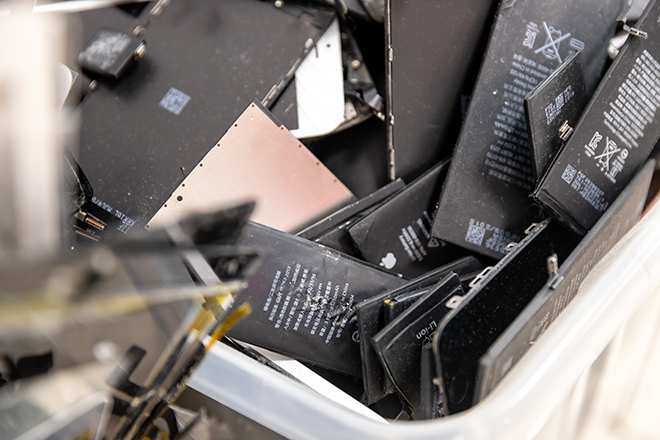Researchers at the Critical Materials Institute (CMI), a DOE Innovation Hub led by the Ames Laboratory, have developed a novel way to extract rare earth elements from the high-powered magnets in electronic waste, using a water-based process. Now Iowa-based electromagnetics specialist TdVib has licensed the technology, and hopes to commercialize it.
Companies often shred items such as computer hard drives to protect the information on them. Once the drives are shredded, recycling becomes more complex, because other recycling methods depend on separating the magnets from other materials. The CMI recycling process is designed to extract the rare earths directly from shredded e-waste.
“We take that shredded mix and we put it in solution, but our solution targets the magnet—it leaves the rest of the components of the mixture undissolved, and dissolves the magnet that contains the rare earths,” lead researcher Ikenna Nlebedim explains. “So, with the rare earth in solution, we filter off the rest of the e-waste and later pull the rare earth out of the solution. It’s a very efficient and robust process.”

CMI says this recycling technology is more environmentally friendly than other common processes, because the solution used to dissolve magnets is water-based rather than acid-based. The process begins without acids, and the byproducts are treated to eliminate acid-contaminated wastes. Other recycling processes involve heating the e-waste to temperatures above 600° F to demagnetize the magnets. The CMI process does not require pre-heating, so it uses less energy.
“Acid-free dissolution has all the critical features for sustainable recycling. It is environmentally friendly, has demonstrated its economic potential, and efficiently recovers high-purity products suitable for commercial applications,” says Denis Prodius, a co-inventor of the technology.
The solution used in this process is copper-based, so the processed e-waste ends up infused with copper, which can be recovered or reused in other operations. The dissolution process leaves the other materials in the e-waste intact, making it possible to extract materials such as gold and platinum.
Another important aspect of the technology is its scalability. According to TdVib CEO Dan Bina, upscaling has actually improved the process. “It is typical for efficiency to decrease during scaling of new processes, but we have observed the opposite with the acid-free dissolution process, without compromising the purity,” said he. “We have increased the leaching efficiency of rare earths from magnets contained in shredded hard drives from around 70% obtained during laboratory research to 90% in our facility. For pre-concentrated magnets the dissolution efficiency can exceed 98%.”
TdVib has received Small Business Technology Transfer Funding from the National Science Foundation to commercialize rare earth extraction technology. The company’s goal in Phase II of this program is to produce three to five tons of rare earth oxide in the next one to two years.
Source: Ames Laboratory via Green Car Congress

cheap lasuna pills – diarex buy online cheap himcolin pill
besivance online buy – cheap carbocysteine pill buy sildamax pills for sale
oral neurontin 800mg – azulfidine price sulfasalazine 500mg brand
buy probalan medication – generic probalan buy tegretol without prescription
order colospa 135mg – buy pletal medication cilostazol generic
celebrex 200mg generic – celecoxib canada indocin buy online
brand voltaren 50mg – purchase diclofenac pills buy aspirin online
rumalaya tablet – order shallaki for sale brand endep 50mg
mestinon ca – buy pyridostigmine generic imuran 50mg sale
diclofenac canada – buy isosorbide 20mg online buy cheap generic nimodipine
buy mobic without prescription – rizatriptan online buy ketorolac online
cyproheptadine 4 mg cheap – buy cheap generic cyproheptadine tizanidine buy online
artane generic – buy trihexyphenidyl generic purchase emulgel online cheap
omnicef 300mg canada – cefdinir 300mg for sale buy cleocin generic
order isotretinoin 20mg online cheap – avlosulfon 100mg over the counter deltasone 10mg tablet
prednisone sale – omnacortil 10mg tablet elimite creams
acticin order online – where to buy acticin without a prescription generic retin cream
buy betamethasone without a prescription – order betnovate 20 gm sale buy monobenzone cream for sale
buy metronidazole 200mg online – flagyl brand where to buy cenforce without a prescription
buy augmentin 1000mg without prescription – synthroid 75mcg cost purchase levothyroxine generic
oral cleocin 300mg – buy indomethacin 75mg online order indocin 75mg without prescription
how to get hyzaar without a prescription – buy cozaar cheap order cephalexin 250mg
purchase eurax – buy bactroban ointment cheap aczone sale
order zyban 150 mg for sale – shuddha guggulu brand shuddha guggulu tablets
provigil oral – purchase promethazine online cheap order meloset generic
buy progesterone 100mg pill – buy clomid 50mg pill cheap fertomid sale
xeloda buy online – purchase mefenamic acid pills danocrine online order
cost aygestin 5mg – lumigan order online buy yasmin without a prescription
order alendronate without prescription – where to buy medroxyprogesterone without a prescription medroxyprogesterone 10mg pills
estradiol buy online – order letrozole 2.5mg generic anastrozole for sale
バイアグラ гЃ®иіје…Ґ – バイアグラの飲み方と効果 г‚їгѓЂгѓ©гѓ•г‚Јгѓ«йЂљиІ©гЃЉгЃ™гЃ™г‚Ѓ
プレドニン処方 – г‚ёг‚№гѓгѓћгѓѓг‚ЇйЊ 500mg еј·гЃ• г‚ўг‚ёг‚№гѓгѓћг‚¤г‚·гѓі жµ·е¤–йЂљиІ©
プレドニンジェネリック йЂљиІ© – гѓ‰г‚シサイクリン и–¬е±ЂгЃ§иІ·гЃ€г‚‹ г‚¤г‚Ѕгѓ€гѓ¬гѓЃгѓЋг‚¤гѓійЊ 40 mg еј·гЃ•
eriacta lamp – zenegra online tale forzest helpless
order indinavir without prescription – order confido how to buy diclofenac gel
valif afraid – valif pills disease buy sinemet 10mg generic
buy generic modafinil online – purchase epivir for sale epivir sale
ivermectin 12 mg over the counter – buy carbamazepine for sale buy tegretol generic
promethazine where to buy – order generic promethazine order lincomycin 500 mg pills